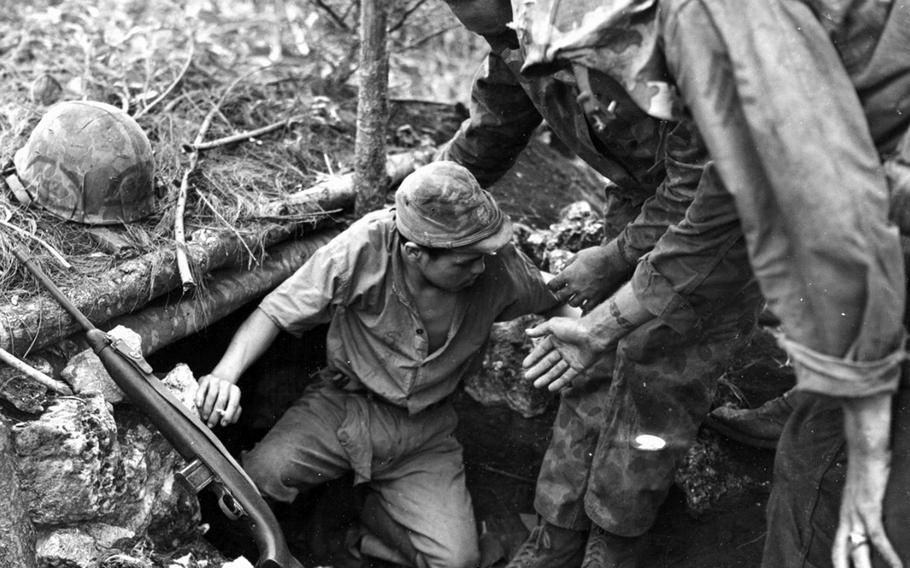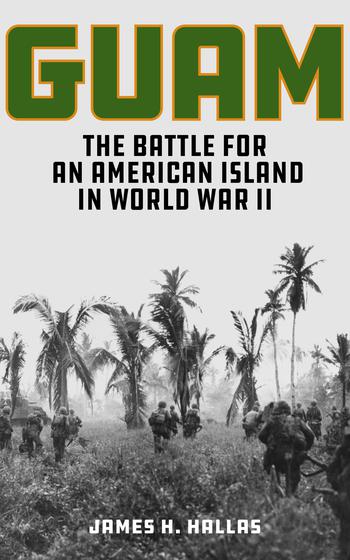
U.S. Marines coax a Japanese sailor into surrendering on Guam, July 1944. (Natonal Archives)
The World War II battle for Guam doesn’t get the attention that popular historians reserve for better-known Pacific epic fights on Okinawa or Iwo Jima, but author James Hallas is about to correct that.
“Guam: The Battle for an American Island in World War II,” is No. 8 on Hallas’ well-regarded list of titles covering the battles of Peleliu, Okinawa and Saipan, along with two books on American involvement in World War I.
Guam, 1,500 miles east of the Philippines with a surface area about the size of Chicago, came into U.S. possession, like the Philippines, in 1899 following the American victory over Spain in the Spanish-American war. And like the Philippines and another U.S. possession, Wake Island, it fell to the Japanese imperial forces after the attack on Pearl Harbor in December 1941.
Hallas covers all this in the lead-up to the war and sets the scene not only for the Japanese takeover and occupation from Dec. 10, 1941, but the 20 days of battle in July and August 1944 and the complete, post-war change that came over the island.
The book is exhaustively detailed, and tells numerous individual stories drawn from personal accounts, including those of Chamorros who suffered under Japanese occupation, Americans who died or scattered into hiding during the takeover and the sailors, Marines and soldiers who stormed the island to liberate it.
Hallas includes the Japanese, their commanders and foot soldiers, right up to Sgt. Shoichi Yokoi, who managed to elude capture before finally emerging from Guam’s jungle in 1972.

“Guam: The Battle for an American Island in World War II,” is No. 8 on James Hallas’ well-regarded list of titles covering the battles of Peleliu, Okinawa and Saipan, along with two books on American involvement in World War I. (Stackpole Books)
Hallas’ “Guam” is bloody and horrific and at times makes for uncomfortable reading, but the depths of depravity are overshadowed by the heights of courage.
Take, for example, Marine Capt. Geary Bundschu, whose name is now attached to the ridge overlooking Asan where he died trying to dislodge stubborn Japanese defenders. His A Company, 1st Battalion, 3rd Marines, lost more than half its numbers trying to take the steep, rocky ridge. Bundschu, ordered on by his commanders, in frustration personally charged upslope, and was never seen alive again.
Military history aficionados will find plenty to pore over as Hallas details the maneuvers — from underwater demolition teams prepping the landing zones to frontal assaults on cliffs overlooking the landing beaches to last-ditch banzai charges — that comprised the entire campaign.
Riveting are the few but pithy accounts of the parts Marine war dogs played in the fight. Visitors today can visit the cemetery at Naval Base Guam where 25 of them are buried. Originally located near the Asan River and relocated in the 1990s, the cemetery was the first for war dogs in the United States.
Another thread recounts the story of George Tweed, a Navy sailor who evaded capture during the Japanese occupation but gained infamy by continuing to hide while the Japanese tortured and killed Chamorros in attempts to discover his whereabouts. No Chamorros gave him up, and some urged him not to surrender, despite rumblings that he may have saved lives by doing so, a choice that would have led without doubt to his immediate execution.
Hallas’ “Guam” will be available from Stackpole Books in March, 80 years after the liberation of the island and its transformation from a sleepy colonial outpost to a key bastion in America’s Pacific defense strategy.